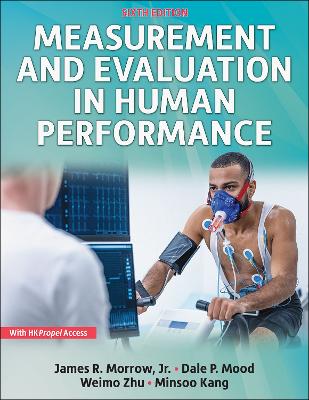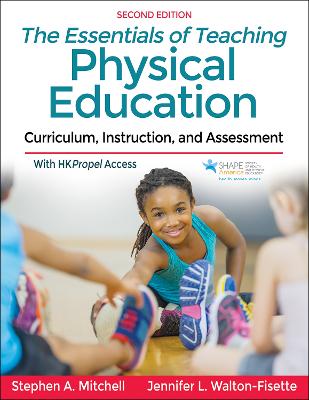Measurement and Evaluation in Human Performance
 -15%
portes grátis
-15%
portes grátis
Measurement and Evaluation in Human Performance
Kang, Minsoo; Morrow, James R., Jr.; Mood, Dale P.; Zhu, Weimo
Human Kinetics Publishers
11/2022
520
Mole
Inglês
9781492599586
15 a 20 dias
1451
Descrição não disponível.
Part I. Introduction to Tests and Measurements in Human Performance
Chapter 1. Concepts in Tests and Measurements
Nature of Measurement and Evaluation
Purposes of Measurement, Testing, and Evaluation
Reliability and Validity
Domains of Human Performance
Summary
Chapter 2. Using Technology in Measurement and Evaluation
Principles and Practice of Using Technology in Assessment
Using Computers to Analyze Data
Using SPSS
Downloading Data Matrices
Summary
Part II. Basic Statistical Concepts
Chapter 3. Descriptive Statistics and the Normal Distributions
Scales of Measurement
Summation Notation
Reporting Data
Central Tendency
Distribution Shapes
Variability
Standard Scores
Normal-Curve Areas (z-table)
Summary
Chapter 4. Correlation and Prediction
Correlation Coefficient
Calculating r
Interpreting r
Prediction
Multiple Correlation or Multiple Regression
Summary
Chapter 5. Inferential Statistics
Hypothesis Testing
Independent and Dependent Variables
Overview of Hypotheses Testing and Inferential Statistics
Effect Size
Selected Statistical Tests
Summary
Part III. Reliability and Validity Theory
Chapter 6. Reliability and Validity
Reliability
Validity
Applied Reliability and Validity Measures
Estimating Agreement Between Measures Using the Bland-Altman Method
Summary
Chapter 7. Criterion-Referenced Tests: Cut Scores, Reliability, and Validity
Setting Criterion-Referenced Standards
Development of Criterion-Referenced Testing
Statistical Analysis of Criterion-Referenced Tests
Criterion-Referenced Testing Examples
Applying Criterion-Referenced Standards to Epidemiology
Summary
Part IV. Human Performance Applications
Chapter 8. Evaluation: Theory and Practice
Evaluations and Standards
Evaluation in School Settings
Process of Grading
Determining Instructional Objectives
Consistency in Grading
Grading Mechanics
Evaluation in Nonschool Settings
Summary
Chapter 9. Developing Written Tests and Surveys
Planning the Test
Constructing and Scoring the Test
Administering the Test
Analyzing the Test
Item Analysis
Sources of Written Tests
Questionnaires and Surveys
Summary
Chapter 10. Assessment of Health-Related Physical Fitness
A Brief History of Physical Fitness Testing
Health-Related Physical Fitness
Establishing the Risk for Fitness Testing and Exercise
Measuring Aerobic Capacity
Measuring Body Composition
Measuring Muscular Strength and Endurance
Measuring Flexibility
Health-Related Fitness Test Batteries
Fitness Test Batteries for Older Adults
Fitness Test Batteries for Children and Youth
Fitness Test Batteries for Special Populations
Summary
Chapter 11. Assessment of Performance-Related Fitness
Measuring Agility
Measuring Balance
Measuring Coordination
Measuring Power
Measuring Reaction Time
Measuring Speed
Measuring Other Performance-Related Fitness Components
Issues Related to Selection, Administration, and Use of Performance-Related Fitness Tests
Summary
Chapter 12. Assessment of Motor Abilities, Skills, and Performance
Testing Motor Abilities
Guidelines for Motor Ability, Skills, and Performance Tests
Effective Testing Procedures
Developing Motor Performance Tests
Issues in Skills Testing
Skills Test Classification
Purposes of Motor Performance Analysis
Sport Analytics
Video Analysis Apps
Employment-Related Performance Testing
Summary
Chapter 13. Assessment of Physical Activity and Energy Expenditure
A Chronological View of Physical Activity and Health Assessment
Physical Activity and Energy Expenditure
Methods of Assessing Physical Activity
Methods of Assessing Energy Expenditure
Selecting a Method of Measurement
Assessing Physical Activity in Children and Youth
Determining Dose of Physical Activity and Energy Expenditure for Health
Summary
Chapter 14. Psychological Measurements in Sport and Exercise
Sport Psychology: Performance Enhancement and Mental Health
Exercise Psychology: Psychological Benefits of Physical Activity
Trait Versus State Measures
General Versus Sport-Specific Measures
Quantitative Versus Qualitative Measurement
Cautions When Using Psychological Tests
New Technology for Assessment Practices
Tests Used in Sport and Exercise Psychology
Summary
Chapter 15. Performance-Based Assessment: Alternative Ways to Assess Student Learning
Impetus for Developing a New Type of Assessment
Types of Performance-Based Assessment
Establishing Criteria for Performance-Based Assessments
Subjectivity: A Criticism of Performance-Based Assessments
Selecting Appropriate Performance-Based Assessments
Issues to Consider When Developing Performance-Based Assessments
Improving Assessment Practices in Physical Education Settings
Summary
Appendix: Microsoft Excel Applications
Chapter 1. Concepts in Tests and Measurements
Nature of Measurement and Evaluation
Purposes of Measurement, Testing, and Evaluation
Reliability and Validity
Domains of Human Performance
Summary
Chapter 2. Using Technology in Measurement and Evaluation
Principles and Practice of Using Technology in Assessment
Using Computers to Analyze Data
Using SPSS
Downloading Data Matrices
Summary
Part II. Basic Statistical Concepts
Chapter 3. Descriptive Statistics and the Normal Distributions
Scales of Measurement
Summation Notation
Reporting Data
Central Tendency
Distribution Shapes
Variability
Standard Scores
Normal-Curve Areas (z-table)
Summary
Chapter 4. Correlation and Prediction
Correlation Coefficient
Calculating r
Interpreting r
Prediction
Multiple Correlation or Multiple Regression
Summary
Chapter 5. Inferential Statistics
Hypothesis Testing
Independent and Dependent Variables
Overview of Hypotheses Testing and Inferential Statistics
Effect Size
Selected Statistical Tests
Summary
Part III. Reliability and Validity Theory
Chapter 6. Reliability and Validity
Reliability
Validity
Applied Reliability and Validity Measures
Estimating Agreement Between Measures Using the Bland-Altman Method
Summary
Chapter 7. Criterion-Referenced Tests: Cut Scores, Reliability, and Validity
Setting Criterion-Referenced Standards
Development of Criterion-Referenced Testing
Statistical Analysis of Criterion-Referenced Tests
Criterion-Referenced Testing Examples
Applying Criterion-Referenced Standards to Epidemiology
Summary
Part IV. Human Performance Applications
Chapter 8. Evaluation: Theory and Practice
Evaluations and Standards
Evaluation in School Settings
Process of Grading
Determining Instructional Objectives
Consistency in Grading
Grading Mechanics
Evaluation in Nonschool Settings
Summary
Chapter 9. Developing Written Tests and Surveys
Planning the Test
Constructing and Scoring the Test
Administering the Test
Analyzing the Test
Item Analysis
Sources of Written Tests
Questionnaires and Surveys
Summary
Chapter 10. Assessment of Health-Related Physical Fitness
A Brief History of Physical Fitness Testing
Health-Related Physical Fitness
Establishing the Risk for Fitness Testing and Exercise
Measuring Aerobic Capacity
Measuring Body Composition
Measuring Muscular Strength and Endurance
Measuring Flexibility
Health-Related Fitness Test Batteries
Fitness Test Batteries for Older Adults
Fitness Test Batteries for Children and Youth
Fitness Test Batteries for Special Populations
Summary
Chapter 11. Assessment of Performance-Related Fitness
Measuring Agility
Measuring Balance
Measuring Coordination
Measuring Power
Measuring Reaction Time
Measuring Speed
Measuring Other Performance-Related Fitness Components
Issues Related to Selection, Administration, and Use of Performance-Related Fitness Tests
Summary
Chapter 12. Assessment of Motor Abilities, Skills, and Performance
Testing Motor Abilities
Guidelines for Motor Ability, Skills, and Performance Tests
Effective Testing Procedures
Developing Motor Performance Tests
Issues in Skills Testing
Skills Test Classification
Purposes of Motor Performance Analysis
Sport Analytics
Video Analysis Apps
Employment-Related Performance Testing
Summary
Chapter 13. Assessment of Physical Activity and Energy Expenditure
A Chronological View of Physical Activity and Health Assessment
Physical Activity and Energy Expenditure
Methods of Assessing Physical Activity
Methods of Assessing Energy Expenditure
Selecting a Method of Measurement
Assessing Physical Activity in Children and Youth
Determining Dose of Physical Activity and Energy Expenditure for Health
Summary
Chapter 14. Psychological Measurements in Sport and Exercise
Sport Psychology: Performance Enhancement and Mental Health
Exercise Psychology: Psychological Benefits of Physical Activity
Trait Versus State Measures
General Versus Sport-Specific Measures
Quantitative Versus Qualitative Measurement
Cautions When Using Psychological Tests
New Technology for Assessment Practices
Tests Used in Sport and Exercise Psychology
Summary
Chapter 15. Performance-Based Assessment: Alternative Ways to Assess Student Learning
Impetus for Developing a New Type of Assessment
Types of Performance-Based Assessment
Establishing Criteria for Performance-Based Assessments
Subjectivity: A Criticism of Performance-Based Assessments
Selecting Appropriate Performance-Based Assessments
Issues to Consider When Developing Performance-Based Assessments
Improving Assessment Practices in Physical Education Settings
Summary
Appendix: Microsoft Excel Applications
Este título pertence ao(s) assunto(s) indicados(s). Para ver outros títulos clique no assunto desejado.
Data; measurement; evaluation; research; analysis; statistics; kinesiology; physical education; validity; reliability; methods; Excel; SPSS; assessment; human performance; sport science; exercise science; testing; calculations; evidence-based
Part I. Introduction to Tests and Measurements in Human Performance
Chapter 1. Concepts in Tests and Measurements
Nature of Measurement and Evaluation
Purposes of Measurement, Testing, and Evaluation
Reliability and Validity
Domains of Human Performance
Summary
Chapter 2. Using Technology in Measurement and Evaluation
Principles and Practice of Using Technology in Assessment
Using Computers to Analyze Data
Using SPSS
Downloading Data Matrices
Summary
Part II. Basic Statistical Concepts
Chapter 3. Descriptive Statistics and the Normal Distributions
Scales of Measurement
Summation Notation
Reporting Data
Central Tendency
Distribution Shapes
Variability
Standard Scores
Normal-Curve Areas (z-table)
Summary
Chapter 4. Correlation and Prediction
Correlation Coefficient
Calculating r
Interpreting r
Prediction
Multiple Correlation or Multiple Regression
Summary
Chapter 5. Inferential Statistics
Hypothesis Testing
Independent and Dependent Variables
Overview of Hypotheses Testing and Inferential Statistics
Effect Size
Selected Statistical Tests
Summary
Part III. Reliability and Validity Theory
Chapter 6. Reliability and Validity
Reliability
Validity
Applied Reliability and Validity Measures
Estimating Agreement Between Measures Using the Bland-Altman Method
Summary
Chapter 7. Criterion-Referenced Tests: Cut Scores, Reliability, and Validity
Setting Criterion-Referenced Standards
Development of Criterion-Referenced Testing
Statistical Analysis of Criterion-Referenced Tests
Criterion-Referenced Testing Examples
Applying Criterion-Referenced Standards to Epidemiology
Summary
Part IV. Human Performance Applications
Chapter 8. Evaluation: Theory and Practice
Evaluations and Standards
Evaluation in School Settings
Process of Grading
Determining Instructional Objectives
Consistency in Grading
Grading Mechanics
Evaluation in Nonschool Settings
Summary
Chapter 9. Developing Written Tests and Surveys
Planning the Test
Constructing and Scoring the Test
Administering the Test
Analyzing the Test
Item Analysis
Sources of Written Tests
Questionnaires and Surveys
Summary
Chapter 10. Assessment of Health-Related Physical Fitness
A Brief History of Physical Fitness Testing
Health-Related Physical Fitness
Establishing the Risk for Fitness Testing and Exercise
Measuring Aerobic Capacity
Measuring Body Composition
Measuring Muscular Strength and Endurance
Measuring Flexibility
Health-Related Fitness Test Batteries
Fitness Test Batteries for Older Adults
Fitness Test Batteries for Children and Youth
Fitness Test Batteries for Special Populations
Summary
Chapter 11. Assessment of Performance-Related Fitness
Measuring Agility
Measuring Balance
Measuring Coordination
Measuring Power
Measuring Reaction Time
Measuring Speed
Measuring Other Performance-Related Fitness Components
Issues Related to Selection, Administration, and Use of Performance-Related Fitness Tests
Summary
Chapter 12. Assessment of Motor Abilities, Skills, and Performance
Testing Motor Abilities
Guidelines for Motor Ability, Skills, and Performance Tests
Effective Testing Procedures
Developing Motor Performance Tests
Issues in Skills Testing
Skills Test Classification
Purposes of Motor Performance Analysis
Sport Analytics
Video Analysis Apps
Employment-Related Performance Testing
Summary
Chapter 13. Assessment of Physical Activity and Energy Expenditure
A Chronological View of Physical Activity and Health Assessment
Physical Activity and Energy Expenditure
Methods of Assessing Physical Activity
Methods of Assessing Energy Expenditure
Selecting a Method of Measurement
Assessing Physical Activity in Children and Youth
Determining Dose of Physical Activity and Energy Expenditure for Health
Summary
Chapter 14. Psychological Measurements in Sport and Exercise
Sport Psychology: Performance Enhancement and Mental Health
Exercise Psychology: Psychological Benefits of Physical Activity
Trait Versus State Measures
General Versus Sport-Specific Measures
Quantitative Versus Qualitative Measurement
Cautions When Using Psychological Tests
New Technology for Assessment Practices
Tests Used in Sport and Exercise Psychology
Summary
Chapter 15. Performance-Based Assessment: Alternative Ways to Assess Student Learning
Impetus for Developing a New Type of Assessment
Types of Performance-Based Assessment
Establishing Criteria for Performance-Based Assessments
Subjectivity: A Criticism of Performance-Based Assessments
Selecting Appropriate Performance-Based Assessments
Issues to Consider When Developing Performance-Based Assessments
Improving Assessment Practices in Physical Education Settings
Summary
Appendix: Microsoft Excel Applications
Chapter 1. Concepts in Tests and Measurements
Nature of Measurement and Evaluation
Purposes of Measurement, Testing, and Evaluation
Reliability and Validity
Domains of Human Performance
Summary
Chapter 2. Using Technology in Measurement and Evaluation
Principles and Practice of Using Technology in Assessment
Using Computers to Analyze Data
Using SPSS
Downloading Data Matrices
Summary
Part II. Basic Statistical Concepts
Chapter 3. Descriptive Statistics and the Normal Distributions
Scales of Measurement
Summation Notation
Reporting Data
Central Tendency
Distribution Shapes
Variability
Standard Scores
Normal-Curve Areas (z-table)
Summary
Chapter 4. Correlation and Prediction
Correlation Coefficient
Calculating r
Interpreting r
Prediction
Multiple Correlation or Multiple Regression
Summary
Chapter 5. Inferential Statistics
Hypothesis Testing
Independent and Dependent Variables
Overview of Hypotheses Testing and Inferential Statistics
Effect Size
Selected Statistical Tests
Summary
Part III. Reliability and Validity Theory
Chapter 6. Reliability and Validity
Reliability
Validity
Applied Reliability and Validity Measures
Estimating Agreement Between Measures Using the Bland-Altman Method
Summary
Chapter 7. Criterion-Referenced Tests: Cut Scores, Reliability, and Validity
Setting Criterion-Referenced Standards
Development of Criterion-Referenced Testing
Statistical Analysis of Criterion-Referenced Tests
Criterion-Referenced Testing Examples
Applying Criterion-Referenced Standards to Epidemiology
Summary
Part IV. Human Performance Applications
Chapter 8. Evaluation: Theory and Practice
Evaluations and Standards
Evaluation in School Settings
Process of Grading
Determining Instructional Objectives
Consistency in Grading
Grading Mechanics
Evaluation in Nonschool Settings
Summary
Chapter 9. Developing Written Tests and Surveys
Planning the Test
Constructing and Scoring the Test
Administering the Test
Analyzing the Test
Item Analysis
Sources of Written Tests
Questionnaires and Surveys
Summary
Chapter 10. Assessment of Health-Related Physical Fitness
A Brief History of Physical Fitness Testing
Health-Related Physical Fitness
Establishing the Risk for Fitness Testing and Exercise
Measuring Aerobic Capacity
Measuring Body Composition
Measuring Muscular Strength and Endurance
Measuring Flexibility
Health-Related Fitness Test Batteries
Fitness Test Batteries for Older Adults
Fitness Test Batteries for Children and Youth
Fitness Test Batteries for Special Populations
Summary
Chapter 11. Assessment of Performance-Related Fitness
Measuring Agility
Measuring Balance
Measuring Coordination
Measuring Power
Measuring Reaction Time
Measuring Speed
Measuring Other Performance-Related Fitness Components
Issues Related to Selection, Administration, and Use of Performance-Related Fitness Tests
Summary
Chapter 12. Assessment of Motor Abilities, Skills, and Performance
Testing Motor Abilities
Guidelines for Motor Ability, Skills, and Performance Tests
Effective Testing Procedures
Developing Motor Performance Tests
Issues in Skills Testing
Skills Test Classification
Purposes of Motor Performance Analysis
Sport Analytics
Video Analysis Apps
Employment-Related Performance Testing
Summary
Chapter 13. Assessment of Physical Activity and Energy Expenditure
A Chronological View of Physical Activity and Health Assessment
Physical Activity and Energy Expenditure
Methods of Assessing Physical Activity
Methods of Assessing Energy Expenditure
Selecting a Method of Measurement
Assessing Physical Activity in Children and Youth
Determining Dose of Physical Activity and Energy Expenditure for Health
Summary
Chapter 14. Psychological Measurements in Sport and Exercise
Sport Psychology: Performance Enhancement and Mental Health
Exercise Psychology: Psychological Benefits of Physical Activity
Trait Versus State Measures
General Versus Sport-Specific Measures
Quantitative Versus Qualitative Measurement
Cautions When Using Psychological Tests
New Technology for Assessment Practices
Tests Used in Sport and Exercise Psychology
Summary
Chapter 15. Performance-Based Assessment: Alternative Ways to Assess Student Learning
Impetus for Developing a New Type of Assessment
Types of Performance-Based Assessment
Establishing Criteria for Performance-Based Assessments
Subjectivity: A Criticism of Performance-Based Assessments
Selecting Appropriate Performance-Based Assessments
Issues to Consider When Developing Performance-Based Assessments
Improving Assessment Practices in Physical Education Settings
Summary
Appendix: Microsoft Excel Applications
Este título pertence ao(s) assunto(s) indicados(s). Para ver outros títulos clique no assunto desejado.




